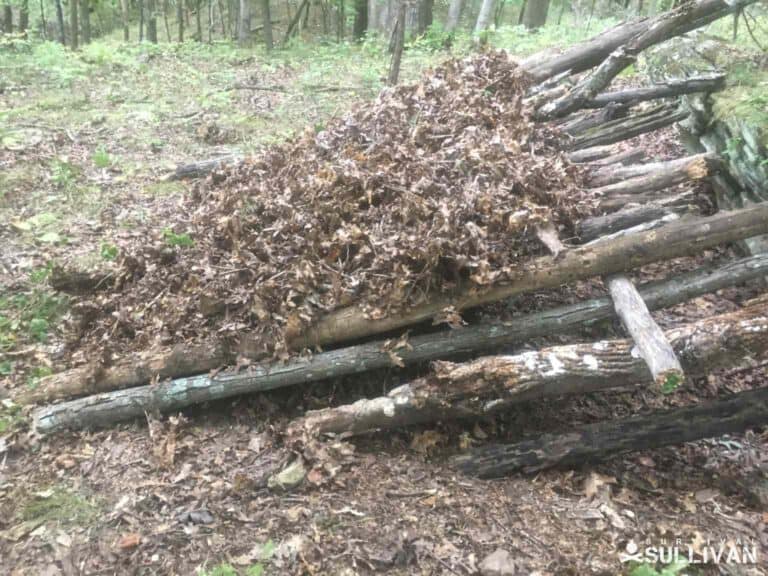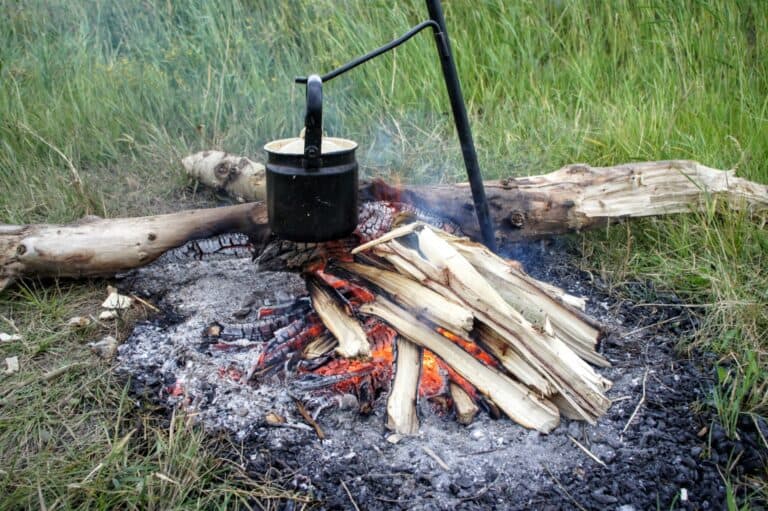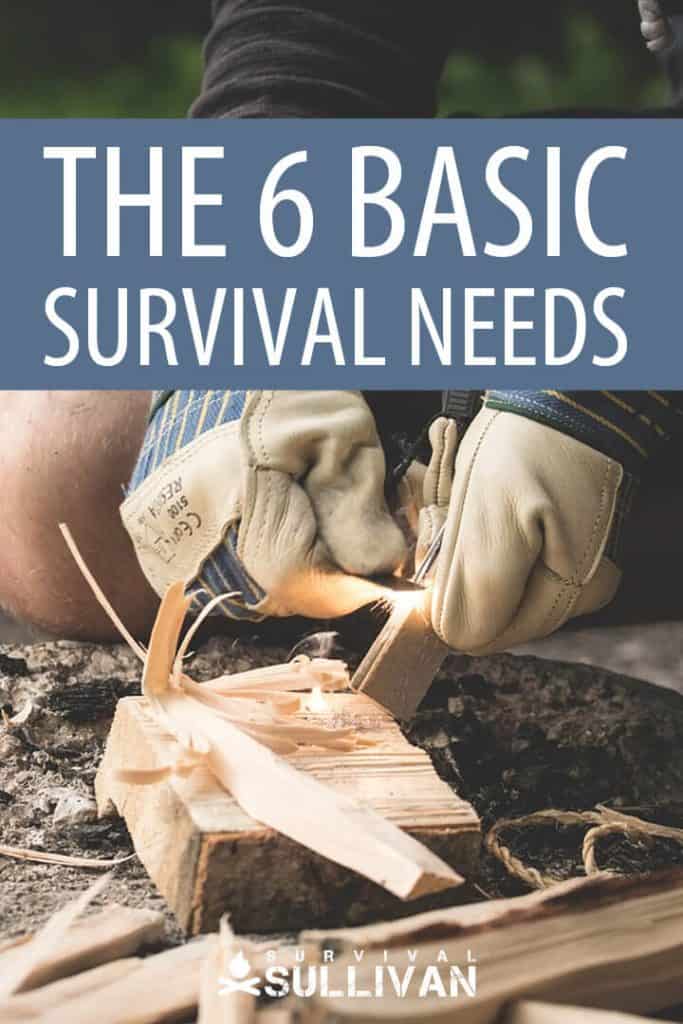Although many preppers have specific events in mind that they are preparing for, there really is no way to predict with any certainty what a post-SHTF world will turn into.
But there are six basic survival needs that, if met, should help you stay alive longer than anyone else. Obviously there will be others, but to physically sustain your body, you need to plan for five of these (while the 6th is not really as basic as the rest, but just as critical).
These basic needs make up the physiological needs level of Maslow’s hierarchy of needs first put together by Abraham Maslow, an American psychologist, in his scientific study of happiness.
Table of Contents
Need #1: Oxygen / Air
All humans need air to breathe in order to survive. It’s the most basic of human needs and probably the one most overlooked by most preppers.
For the average adult, about three minutes without air is all it takes for them to start feeling lightheaded and dizzy and brain damage can occur for some people after only five minutes without oxygen.
What Threatens Our Need for Air
The medical term for complete shutdown of oxygen to the brain is called cerebral anoxia.
We all know that things such as cardiac arrest, drowning, anaphylactic shock, asthma attacks, and other medical emergencies can restrict our access to oxygen.
We need to prepare to treat this by learning and practicing CPR and other first aid treatments. The medical term for decreased oxygen to the brain is cerebral hypoxia.
Symptoms of Cerebral Hypoxia:
- Poor judgement
- Inattentiveness
- Memory loss
- Reduced motor coordination
Cerebral hypoxia that lasts for an extended time can lead to seizures, coma, and brain death.
In a grid down situation or post-SHTH scenario there are other environmental and medical factors that can limit our oxygen that we need to prepare for as well.
Smoke Inhalation
A grid down or natural disaster situation can mean there will be more frequent house fires which even if it’s not your house on fire, can mean that there is a greater amount of smoke filling the air around your home. A house on fire next door to you while you are sleeping could mean you wake up feel woozy with soot in your nose.
Temporary exposure to too much smoke can irritate your eyes, cause your throat to burn or your voice to become hoarse and can give you a headache.
Smoke inhalation can cause constant coughing, fatigue, a tingling or numbness in your tongue, nausea or vomiting, and even achy joints. Symptoms sometimes don’t appear for 24-48 hours after you’ve been exposed to the smoke.
Recommendations: have an N95, N99 or N100 respirator as part of your EDC or get home bag. Install smoke detectors in every room of the house.
Carbon Monoxide Poisoning
This type of poisoning occurs whenever there is too much carbon monoxide in the air you are breathing. Carbon monoxide poisoning can occur whenever you are around fuel burning machines, such as a car exhaust, furnace, even a charcoal grill, without proper ventilation in place.
Carbon monoxide replaces oxygen in your blood cells and your tissues and organs are prevented from getting the oxygen that is vital for them function properly.
During a power outage, natural disaster, or other SHTF event, machines are more likely to malfunction. People desperate to feed their families and keep them warm can sometimes make poor decisions about the use of heaters and grills.
Carbon monoxide is sneaky because you may not be aware that you are being poisoned. Things to watch for include weakness or dizziness, a dull headache, shortness of breath, blurred vision, confusion, nausea or vomiting, and loss of consciousness.
Recommendation: install CO detectors in every room of the house where CO may form. In addition, you can opt for sensors that can detect both CO and smoke.
High Altitudes
During a bug out situation due to flooding or other disaster, you could find yourself bugging out to higher ground.
Depending on where you live, this could mean you and your family will be at risk of high altitude sickness, mountain sickness, or more critical forms which are (HAPE) high-altitude pulmonary edema and high-altitude cerebral edema.
These sicknesses are caused due to the smaller amounts of oxygen available as you move to higher altitudes.
The early signs of high-altitude sickness include a headache that throbs and seems worse at night and when you wake up, reduced appetite, nausea or vomiting, dizziness, as well as both fatigue or insomnia.
Prolonged exposure can produce extreme fatigue, shortness of breath, lung failure, and cerebral edema. High altitude sickness can cause a person to go into a coma and can be fatal if not treated.
The reason the need for fresh air becomes so critical in a survival situation is because of how even a small amount of impairment in oxygen can negatively impact our senses.
If you or a loved one are experiencing a threat to your oxygen level and you aren’t aware of it, you could be slow to react or make decisions that put you in more danger.

Need #2: Shelter / Warmth
Shelter and warmth are technically two different needs but they do tend to go hand in hand during a survival situation. There are many, many stories of people who have been unexpectedly stranded without the knowledge or resources to get and stay warm.
The average person can survive only about three hours in extreme weather without a survival shelter. The biggest dangers are exposure to extreme heat, extreme cold, and to rain.
In many cases, one person goes for help while leaving the other person in a car, cave, etc. Some of these stories have by the grace of God had a somewhat happy ending.
Others have ended tragically, most often for the person who remained exposed to the elements to seek help, sometimes for everyone who was stranded.
So shelter and warmth go hand in hand. You must be prepared in any situation to start and maintain a fire for warmth.
Even the most mundane of day trips can turn into an overnight nightmare due to an unexpected change in weather, an unpredictable injury, a fall in the creek, etc. Being able to start a fire to get dry and build a shelter to stay warm overnight or until help arrives can mean the difference between life and death.
Hypothermia
One of the biggest risks of being exposed to extreme wet conditions or extreme cold conditions for any length of time is hypothermia. This is a condition that occurs when the human body is unable to maintain the proper temperature due to extreme cold.
Hypothermia can occur in a matter of minutes in icy water or over a longer period of time in cold weather.
The best way to prevent hypothermia is to stay warm and dry. If you can build a fire and maintain it, you’ve won half the battle. If you do get wet while in a survival situation, be prepared to change out of your wet clothing into something dry.
For anyone exposed to extreme cold that has drastically lowered body temperature, warm up gradually with blankets, body heat from other individuals, or warm beverages.
Most of us have heard the warnings about frostbite, and many preppers know to keep extremities and skin covered during extremely cold weather. What you may not realize is that getting wet during even mildly cold weather can lead to frostbite and even hypothermia if you aren’t careful.
Sun or Heatstroke
Sun stroke, sometimes referred to as heat stroke is a life-threatening medical condition that most often results from an individual who has been working or exercising for too long in a hot environment or even sitting in a hot environment without any relief from the heat.
When the body temperature gets to 104 degrees Fahrenheit or 40 degrees Celsius, the situation can be life-threatening.
Heat Exhaustion
Someone who has lost fluids and become too hot can begin to experience fatigue, muscle cramps, and weakness, a condition referred to as heat exhaustion. Heat exhaustion, if untreated, can progress to heatstroke as discussed above.
A person exposed to the sun for a long period of time without any relief is at risk of heat exhaustion and heatstroke. In these circumstances, shelter from the sun becomes critical to survival.
If you are suffering from exposure, whether to extreme heat or cold, again your ability to make good decisions is likely impaired. The longer you are exposed to the elements and the longer you go without treatment, the more severe the impairment becomes. In a survival situation, impaired decision making can be fatal.
Need #3: Water
The next crucial survival need is for fresh water. About 60% of the human body consists of water. It’s a needed component for every cell in our bodies and it acts as a joint lubricant, helps to flush waste and toxins, and to balance body temperature via respiration and perspiration.
Water as a regular part of our daily consumption is also needed for food digestion and proper absorption.
The average adult can survive without water for about three days in extreme conditions (such as sun exposure or physical exertion) and as much as one week under normal conditions (indoor temperatures without exertion).
For a child left in a hot car, the time is much less. In extreme conditions our bodies can lose over a liter of water per hour via perspiration. For anyone with pre-existing health issues, lack of water can cause problems much sooner than three days.
Again, lack of water impairs your ability to complete tasks that are critical for your continued survival. Fresh water is a critical resource on a daily basis for the average adult to remain coherent and capable of physical activity. Fresh water at regular intervals is even more critical for children, elderly, and the disabled.
Dangers of Dehydration
In a survival situation, when water being lost through perspiration cannot be replaced fast enough, total body fluid levels drop quickly and in turn cause the volume of blood in the body to drop also.
When blood volume drops too low, perspiration ceases and causes body temperature to become unbalanced. Poor blood circulation can also lead to a fatal drop in blood pressure. Your body functions are in danger when more than 10% of your body weight is lost through dehydration.
You can replenish body fluids somewhat with other liquids such as milk, juice, coconut water, or the syrups in canned fruit or water in canned vegetables.
Avoid alcohol at all costs as it causes increased urination and increases the rate of dehydration. The recommended amount of water intake is at least 64 ounces per day and in a post-SHTF scenario where your body is being pushed to its physical limits, drinking water regularly throughout the day is even more important for you to remain healthy.
So a crucial part of your survival planning needs to revolve around your ability to secure, filter, and purify water for drinking in sufficient quantities that you can keep you and your family or group members fully hydrated.

Need #4: Food
There is no doubt that food is important to survival. But did you know that the average person can survive three weeks or longer without food? This doesn’t mean that survival food should not be a crucial part of your planning.
A person may be able to physically keep their body alive without food for three weeks or even longer, but that doesn’t mean they will be able to function.
Malnutrition was a big health issue during the Great Depression, not that long ago actually. Many people, including children, suffered from malnutrition.
Contrary to popular belief, malnutrition isn’t just about not having enough volume of food, it’s also about not having the right kinds of food to replenish your body and keep it working properly.
When you consider foods that you will stockpile, it’s crucial that you understand what the human body needs in order to survive and function well. Many people don’t think about which nutrients their body needs when they are planning for survival food.
10-30% calories from Protein
Protein is an important part of the diet for the human body because all of cells need protein to thrive. The body depends on protein to provide it with a form of nitrogen that doesn’t come from lipids or carbohydrates.
Protein in the body also helps to balance pH levels in the blood which are crucial to many functions. Preps to stock that are high in protein include things such as peanut butter, eggs, legumes, oatmeal, nuts, popcorn, canned fish and other meat, wheat, and quinoa.
30% calories from Fats
Although many people talk about eliminating fat from their diet, it actually is a crucial component for so many different functions including protecting organs in the body from shock, body temperature maintenance, the healthy function of cells, and healthy hair and skin.
To maintain crucial fat levels in your diet during a post-SHTF event stock up on whole milk, plant-based oils, seeds, and nuts.
45-65% calories from Carbohydrates
Carbohydrates are crucial because they not only provide energy and protect proteins in our body, they reduce risk factors for cardiovascular disease, obesity and type 2 diabetes.
They also are crucial for digestive health. Stock up on things such as oats, wheat, pasta, cereal, and white rice as well as honey, sugars, and fruit. Fruits and vegetables, especially root vegetables and tubers.
Vitamin and Mineral Deficiencies
In addition to the above requirements, your body also depends on specific levels of various vitamins and minerals to grow, to protect against disease, to remove waste, and for metabolism.
Vitamin deficiencies when left untreated can result in physical problems that will of course have an impact on well you can function post-SHTF.
Here are just a few of the problems that can occur from lack of:
- Vitamin C bleeding gums, poor wound recovery, scurvy
- Riboflavin dental problems including inflammation of the tongue and mouth
- Vitamin B12 anemia, reduced nerve function
- Niacin dermatitis and diarrhea
- Thiamin weakness and edema
- Biotin anemia and soreness of the tongue
- Folate tongue inflammation and poor growth
- Pantothenic Acid Tingling of the hands, fatigue
Things to stock up on include sprouts, “survival” bars, Vitamins C and D, as well as multi-vitamin supplements, and fresh fruits and vegetables (dehydrated if necessary).
Need #5: Safety and Security
Whether you’re bugging out to the forst, with your car or you’re hunkering down at home, the safety and security of you and your family in a survival situation is paramount.
Post collapse, people will want to take your food, your guns, or even hour life. They will be desperate, and with law enforcement overwhelmed, they’ll gain a lot of confidence to hurt other people.
There are various layers of security you can implement, such as:
- personal security measures (fitness, EDC weapons, martial arts, becoming a gray man etc.)
- securing your camp site or temporary bug out location
- securing your apartment
- or your home from the suburbs or small town
Need #6: Sleep
The need for sleep is often unacknowledged when it comes to survival planning. But lack of sleep is already affecting over 35% of adults across the United States daily.
The National Department of Transportation reports that driving while tired or drowsy contributes to over 1500 deaths annually and approximately 40,000 injuries.
So many of us neglect the need for proper sleep now, when times are “normal”, it is inevitable that in a grid down or post-SHTF event, there will be massive numbers of people running on little or no sleep at all.
Many people, including preppers, feel that sleep is a luxury. They assume that it will be enough to just find time to sleep here and there amid all the chaos. Their main thoughts are around keeping the family fed and safe from harm.
Benefits of Sleep
But what many people, even preppers don’t realize is that getting enough sleep is biologically necessary for our survival. The ability of the human body to repair its own cells is very dependent on periods of deep sleep, also known as Non-REM sleep.
It’s during this deep sleep that our bodies are able to heal itself from physical activity, stress, tainted air, toxins and other contaminants we were exposed to throughout the day.
Sleep is crucial for our bodies to fight off illnesses. The immune system of the human body kicks into overdrive during the restful period of the sleep cycle and it battles bacteria and other germs that can turn into infection or disease.
Ailments such as cold and flu, heart disease, diabetes, obesity, and mental illness have been linked to a chronic lack of sleep.
We need sleep to keep us sharp, alert, and active. These are all things that will be vitally crucial to our ability to stay alive and protect our family from harm.
People experiencing a chronic lack of sleep experience physical sluggishness, a decrease in concentration, and even slower reflexes. Can you picture someone like that trying to lead their family to safety during a bug out or to evade or even fend off looters? Exactly.
Your Sleep “Sweet Spot”
Now we know how important sleep is to our overall survival and our ability to keep ourselves and our family safe from harm. Hfow much sleep do we actually need and how can we plan so that sleep is possible?
The amount of sleep you need is an individual thing and it is hard to predict because it fluctuates when you are ill or under a lot of stress. We will all probably be under a lot of stress in a post-SHTF scenario, right?
The best possible thing you can do to prepare for sleep post-SHTF is to make sure you understand your need for sleep now, during “normal” activity and stress.
The recommended amount is seven to nine hours every night, but this will vary for each person and it will fluctuate with your own circumstances. So to properly plan for SHTF, it’s important to know your sleep “sweet spot” now.
If you document the amount of sleep you get every night and take notes the next day about how you feel, your level of alertness, etc. you will soon begin to see where your sleep “sweet spot” lies.
Once you know your own individual “sweet spot” then begin to experiment a little bit, reduce the amount of sleep you get by 30 minutes every night and record your body’s reaction. Then an hour less, etc.
By documenting your sleep patterns and how your body reacts to stress as far as needing more sleep, you will be more aware of your limits during a bug out or SHTF situation.
Once you know your limits and that of your family or group members, you will be able to plan your bug out so that everyone can get the rest they need to stay physically and mentally alert and ready to respond to danger.
Are there other survival needs? Absolutely. There are many of them that must be considered and planned for at some point. But these are the five needs that are crucial for your physical body to survive.
Obviously, you’ll need to plan for self-defense and other security issues so that you are not killed by a looter or some other intruder. But when you are creating or reviewing your survival plans, make sure that your preps have first accounted for these five main ones.


Born and raised in NE Ohio, with early memories that include grandpa teaching her to bait a hook and watching her mom, aunts, and grandmothers garden, sew, and can food, Megan is a true farm girl at heart.
For Megan, the 2003 blackout, the events of 911, and the increasing frequency of natural disasters like Hurricane Katrina, spurred a desire to be more prepared. Soon to be living off-grid, this mother of four and grandmother of ten is learning everything she can about preparedness, survival, and homesteading.
